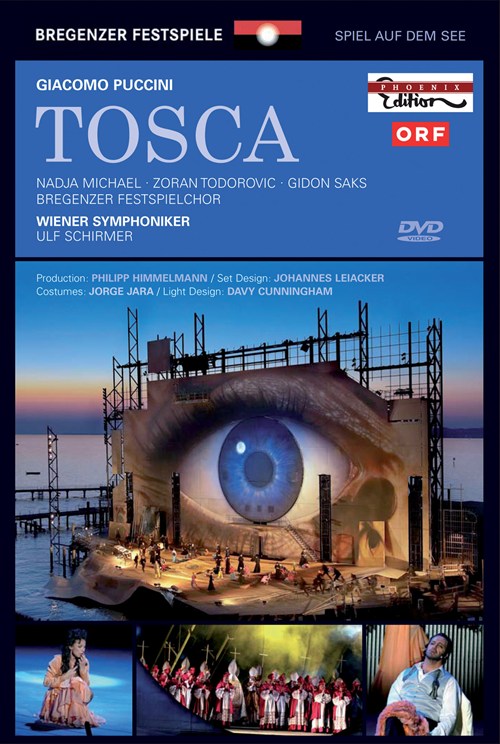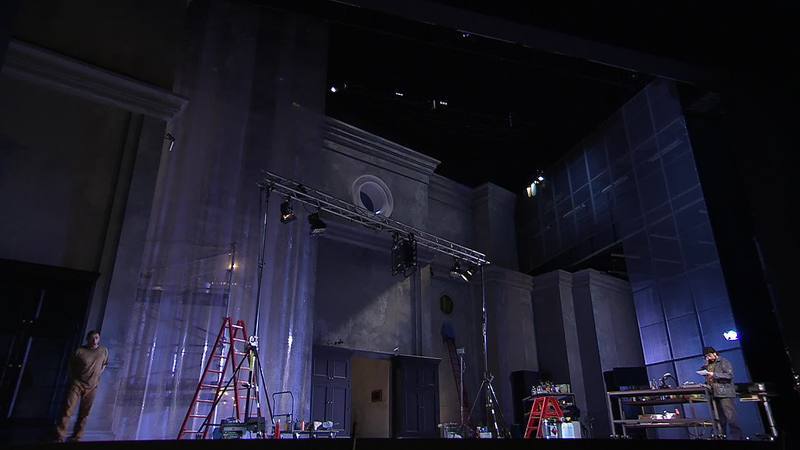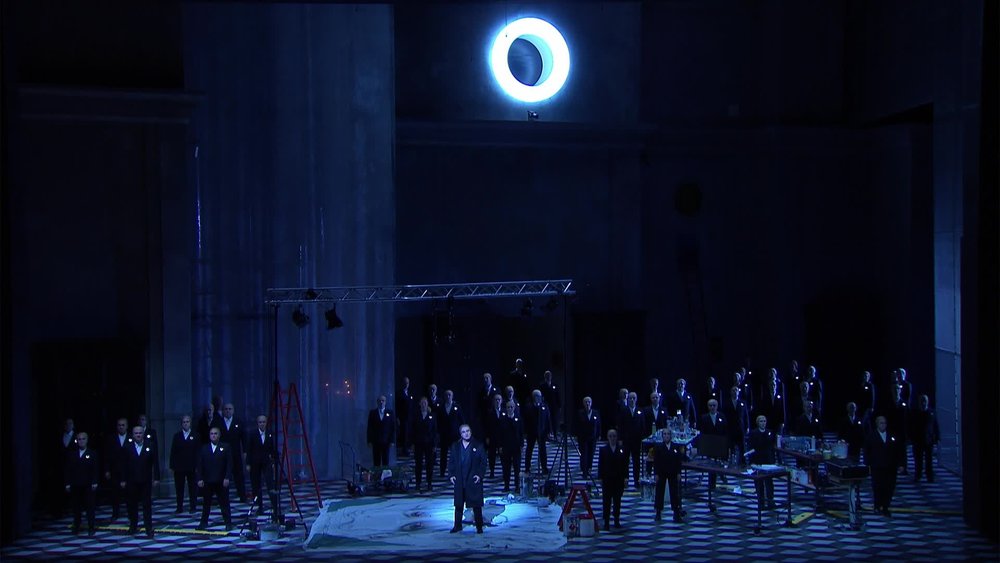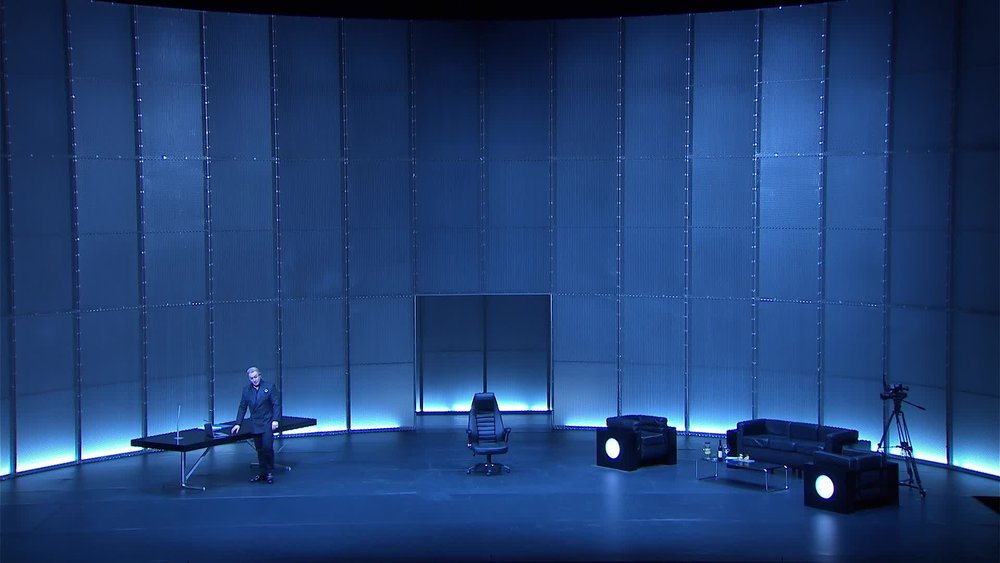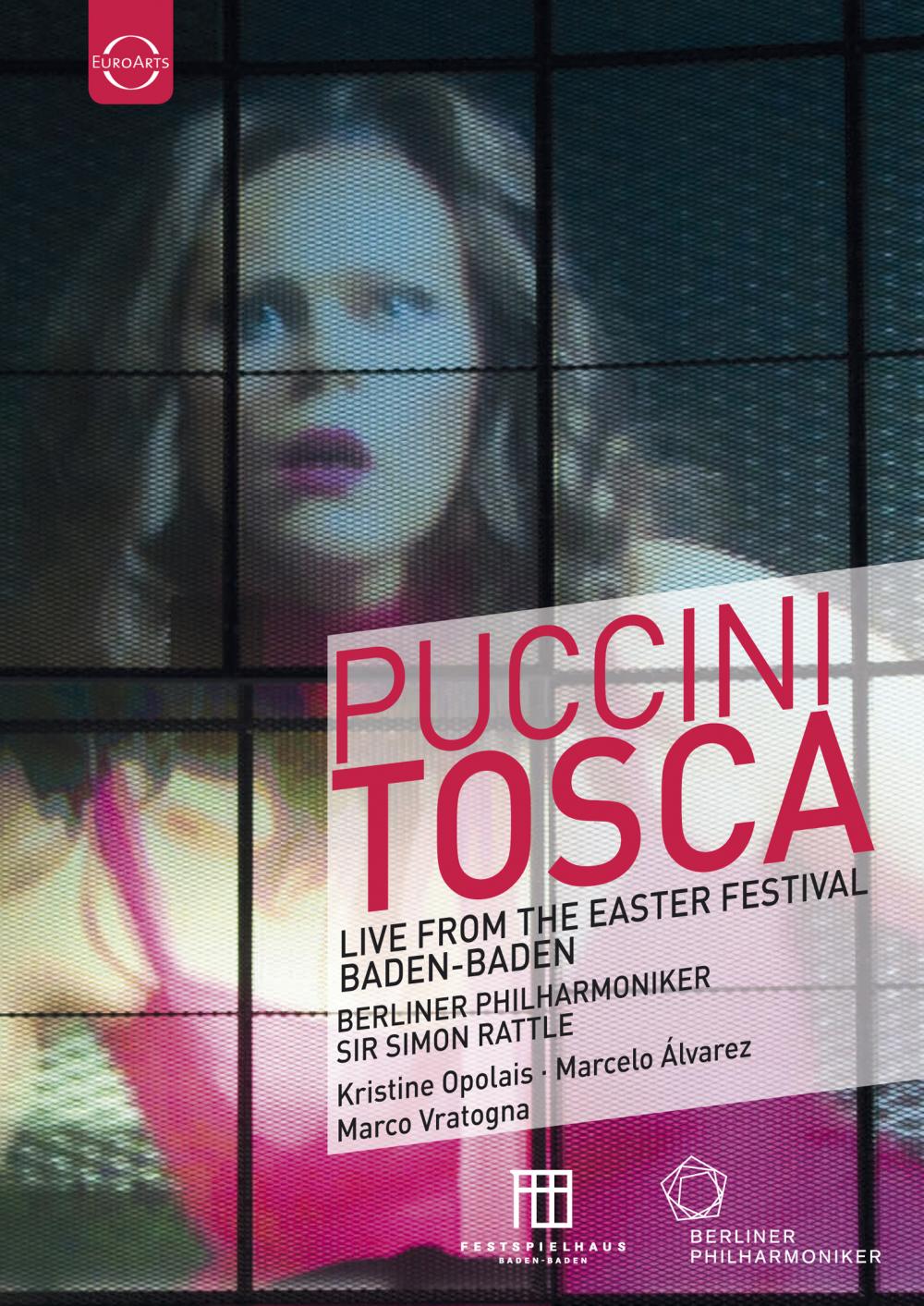
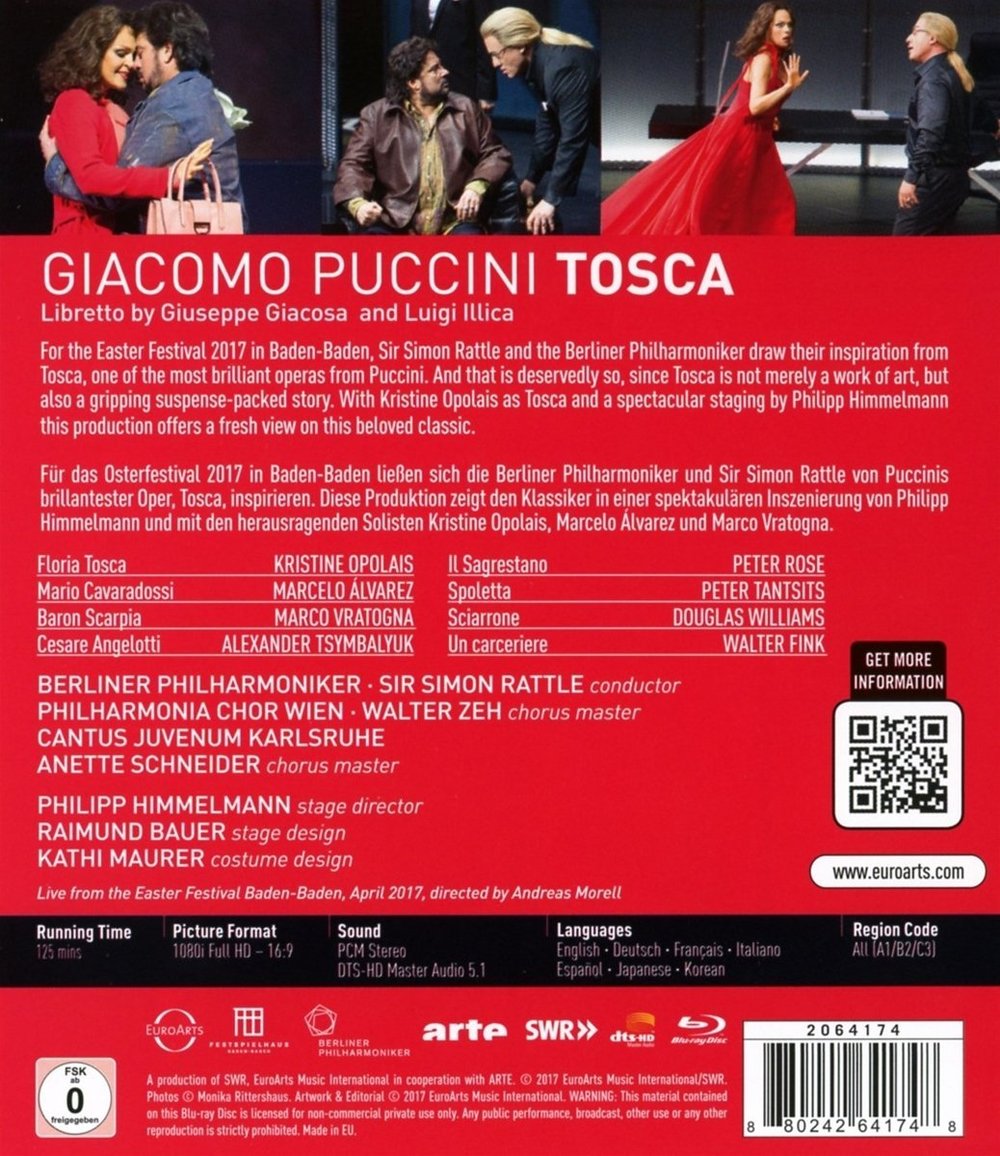
Puccini Tosca opera to libretto by Giuseppe Giacosa and Luigi Illica. Directed 2017 by Philipp Himmelmann (apparently replacing director Bartlett Sher on short notice) at the Easter Festival in Baden-Baden. Stars Kristine Opolais (Tosca), Marcelo Álvarez (Mario Cavaradossi), Marco Vratogna (Baron Scarpia), Alexander Tsymbalyuk (Cesare Angelotti), Peter Rose (Il Sagrestano), Peter Tantsits (Spoletta), Douglas Williams (Sciarrone), Philippe Tsouli (a Boy), and Walter Fink (the Jailer). Sir Simon Rattle conducts the Berliner Philharmoniker, the Philharmonia Chor Wien (Chorus Masters Walter Zeh), and Cantus Juvenum Karlsruhe (Chorus Master Anette Schneider). Set design by Raimund Bauer; costume design by Kathi Maurer; lighting by Reinhard Traub; video designs by Martin Eidenberger. Executive Producer was Alexander Pereira. Directed for TV by Andres Morell. Sung in Italian. Released 2017, disc has 5.1 dts-HD Master Audio sound. Grade: F+
When I first saw (in EuroArts PR) the front cover above with Opolais staring out in horror, I thought, "Great! Tosca as a modern thriller, maybe set in Fascist Italy." I remembered the Bertolucci movie The Conformist. Wrong. Subject Tosca is set in a futuristic total-surveillance state. Now putting Tosca in the time of Big Brother is perhaps not a bad idea. But it would require a lot of work and money to build convincing sets, design costumes for the future, and also tricky dealing with the libretto to get rid of cannons, Napoleon, hiding in wells, firing squads, and the like. It appears subject Tosca was originally to be directed by Bartlett Sher, but Phillip Himmelmann was brought in to replace Sher on short notice. Getting a new opera director in the door as an emergency hire sounds really dangerous!
Well, Himmelmann had some experience to fall back on. As you can see from the first screenshot below, he did an unusual Tosca in 2007 at Bregenz:
Maybe it was the big eye at Bregenz that gave Himmelmann the idea for his surveillance state at Baden-Baden. Next below is a picture the audience at Baden-Baden never saw, but Andreas Morell included it in his video. Subject Tosca opens in a Catholic church, but it's an unusual Catholic church. The Christian cross has been replaced by a monumental double circle structure, which is the Unity Logo of the Unity Cult (my terms) that has taken over society. The Unity Logo might reminds one of an eye, or a camera lens, the business end of a pistol, or the sacred unity of a people—all things that one might encounter in a future dictatorship:
So far so good. Himmelmann sent in his carpenter and seamstress. But from here on things start to fall apart, and one gets the impression this may have been the only opera in history that was directed by email. Next below we see the church Sacristan (Peter Rose) and "the boy." In the libretto, the boy is the shepherd who sings a sad solo in the "Puccini interlude" or prelude to Act III. (The shepherd is tending his sheep on the meadows that still existed in the heart of Rome in 1800.) Himmelmann promotes the boy to a larger (but mostly mute) role as assistant or apprentice to the painter Cavaradossi. But what 12-year-old boy who works for a painter will always looks so clean and be dressed in such sharp clothes? In the image below, the Sacristan is showing an inappropriate degree of interest in the youngster. Apparently the Unity Cult encourages sex with children—bad hombres!
Now we must deal with Marcelo Álvarez as Cavaradossi. Álvarez has been around for a long time, knows the business well, and is still a fine singer. He will probably serve well in roles like Cavaradossi for more years to come on stages in big opera houses. But this guy, with his big belly, bulbous nose, and tendency to make goofy faces, can't be a leading man in a Blu-ray opposite a woman as young and gorgeous as Kristine Opolais. It's out of the question, as you will soon see. And where did they get Marcelo's shirt below?
The church scene in the opening screenshot above is the ugliest and most poorly designed set I can remember. Nothing about it makes any sense. What is a picture of Madonna (who looks like a model for eye makeup) doing in the church of the Unity Cult? Why is the artist using such shabby and primitive tools to paint a huge mural-like poster? And why is the painting on the floor where nobody in the live audience can see it? There are 3 different images of Cavaradossi's painting in the two screenshots below. Why are the images all different, and why is one projected on a wall above the door in this otherwise bare building? And will painters in the future use cheap SD TV sets to monitor their work?
Next below Cavaradossi sings about the "two beauties" ("Recondita armonia") in the form of a lecture to the boy. And Cavaradossi is standing on the painting. Before the opera is over, just about everybody will stand on or wallow about on Cavaradossi's original:
Next below we see Alexander Tsymbalyuk as Cesare Angelotti, who has just escaped from prison. But would it have been possible for Angelotti to escape from a surveillance-state prison and make his way successfully through the streets of a big city full of street cameras and into a big church, all the while dressed in rags and with his hands in cuffs behind his back? And don't you think his host Cavaradossi would notice the minor inconvenience of Angelotti's being on the lamb with his arms pinned this way? Later in this scene Cavaradossi gives Angelotti a basket of food by hanging the basket on the handcuffs. And you will recall, I'm sure, the basket is later found empty. How did Angelotti eat the food in the basket? How does Angelotti later climb into a well to hide with no hands? And who put that ghastly wig on poor Tsymbalyuk? All of these problems should have been solved by sending the director more emails!
Poor Opolais is under contract and trapped in the mess. Here you see her dripping with sarcasm at what is happening to her:
United States Senator Al Franken (who was a comedian by trade) got into trouble (in part anyway) because it was revealed (years after the event) that he forced a young starlet to kiss him realistically in a rehearsal for a skit that would be used to entertain soldiers in the field. Maybe that was sexual harassment. But I would think that serious movie stars and theater actors expect to kiss realistically in rehearsal as well as in actual performance. How do opera singers kiss when they know that they are being filmed for video? Sophie Koch did a pretty good job kissing Jonas Kaufmann in Werther. Angela Gheorghiu and Roberto Alagna really go at it their Tosca, but then they were married in real life. So how about Opolais and Álvarez? Well what you see below is as bad as it gets. I think Opolais would rather have teeth pulled on stage than kiss her sad-sack leading man. Print critics lamented that Opolais and Álvarez often stand 30 feet apart as they sing their love scenes. Álvarez should have sent Himmellmann a letter, Certified Mail, Return Receipt Requested about that.
Below find Marco Vratogna as Baron Scarpia, head of the Security Police in Securitiville. I worked hard to get this shot, which shows for sure that the glasses have no lenses:
Next below we have Scarpia and Peter Tantsits as henchman Spoletta. All the Designates (my term) of the Unity Cult have the same Scarpia getup like so many Barbee dolls. Note the Unity Logo glowing on the lapel of each Designate:
And when enough Designates arrive at the church, the Unity Logo lights up in their honor:
The line below needs to be changed to "Tosca, you make me seek Unity."
In the libretto, Scarpia invites Tosca into his home (nicely equipped with a torture chamber) at the Palazzo Farnese, where he is having a steak dinner. This gives a reasonable explanation why Scarpia is not surrounded by bodyguards and Tosca has access to a steak knife. In Himmelmann's version it appears Scarpia conducts his investigations at the office of the Chief of Police. On command the walls display security video of various locations, a scene familiar to anyone who has seen views of the control room at the Houston Space Center, a nuclear power plant, or at a major shopping center. All of this is potentially impressive as a dystopian vision of the future. But how is Tosca going to kill the Police Chief at Police Headquarters and then slip away unnoticed?
Oh, how clever—Scarpia has a laptop! But so does every well-organized junior-high student. So bringing a laptop on stage just cheapens the effect the stage designer is going for with camp mockery:
The libretto has Cavaradossi tortured with a device clamped to his head "spurting blood." Here we do see a head wound, but take a look at those hands! Where did they come from?
The hands came from the Frankenstein shelf in the props department. In the next image below you can clearly see end of the prop with the shirt sleeves pulled down a bit:
Where can we find a knife to use on Scarpia? When Cavaradossi is rolled on stage from the torture chamber, a nurse is with him. She has in her kit a small scalpel for cutting bandages. In the presence of the Chief of Police and his henchmen, Tosca gets her hands on the scalpel and cuts her lover free. That is in itself is rather improbable. And in the image below, she cuts the binding cord with the dull back of the scalpel! How did that get by editor Claudia Enders?
Scarpia makes a video of his negotiations with Tosca. How original! And the camera he's using looks like it was picked up at the local charity bargain store. Still, the low-resolution image of Tosca on the wall behind is maybe the best image of Opolais on the disc. It fooled me into buying this title:
The assassination scene is ridiculous. The scalpel isn't designed to pierce, nor is it long enough to reach a victim's vital organs. Opolais appears to be grasping the blade in part with her fingers, and her blows with the knife are ludicrous weak. Maybe little of this would clearly be evident to the live audience. But none of this in the video would convince a 5-year old:
The office wall is reused as the side of the prison in the last act. Below you see the lovers saying good-buy from opposite sides of the stage. There are more howlers of bad personal direction coming up, but I'll stop now for fear of being accused of piling on:
EuroArts knew they had a loser. The 4-page keepcase booklet (six pages of text in English and German only) is maybe the shoddiest on record from a major publisher. But there's one warm chestnut here I haven't yet mentioned: Rattle and the Berlin Philharmonic Orchestra in the pit. Rattle must have been aware of the catastrophe unfolding on the boards. But this was his first Tosca, so he got his Phil to play it like it was a world premiere. All the print critics who attended this live lauded the orchestra with comments like that of Shirley Apthorp in the Financial Times who compared the music from the pit to a "trip in a Lamborghini that you usually make by bus." (Apthorp was harshly critical of the rest of the show and gave it 2 out of 5 stars.) Well, by the time an opera reaches the HT in a video, the importance of what you see is magnified and the relative importance of the orchestral performance is diminished. My view is that this video should have been abandoned to protect the public and the EuroArts brand. So I wouldn't feel right about even a D for this title. But out of respect for the Berlin folks, I'll give this the rather illogical grade of F+.
OR
